
Save this storySave this storySave this storySave this story
I remember the first time I came across a physique photograph, and the simultaneous excitement and confusion I felt when looking at it. I was probably eight or nine years old, a boomer child, spending time with my family on the Jersey Shore. We stopped at a store on the way home from a day at the beach, and I was rummaging through the magazine rack while my mother shopped. I don’t remember picking up the magazine, but it opened to a page that startled and terrified me. Two nearly naked teenagers posed for a photograph titled “Victor and Vanquished,” one slung over the other’s shoulder, the spoils of a heated, if not hostile, war. Both boys were smiling, full of enthusiasm, but I was focused on their points of contact, especially where the Vanquished’s bare area touched the Winner’s bare shoulder. What was that? What could it mean? Thinking about it made me giddy and excited, more than I realized. When one of my sisters came over and said we were leaving, I had to cover my swimsuit, already feeling embarrassed.

Photograph of Bruce Bellas (Bruce from Los Angeles), circa 1948.

Photograph by Russ Warner, circa 1945.
A few years later, I began sneaking magazines like Adonis, Body Beautiful, and Tomorrow’s Man home from an out-of-town newsstand. I was still considerably younger than their target audience: gay men for whom sex in the mid-1950s was secret, risky, and illegal. The photographs and the magazines that presented them were part of an erotic life that the randy teenager I had become could only imagine. But that was the point: Like the women who filled the girls’ magazines, these men were there to titillate us. Obscenity laws, most vigorously enforced by the U.S. Postal Service, tried to keep that titillation within strict boundaries—no exposed or overtly erect penises, no gentle or provocative touching. By pushing those boundaries, the best physique work was subversive. Though they were borderline illegal enterprises, the most striking had a rock ‘n’ roll sensibility:
Sourse: newyorker.com